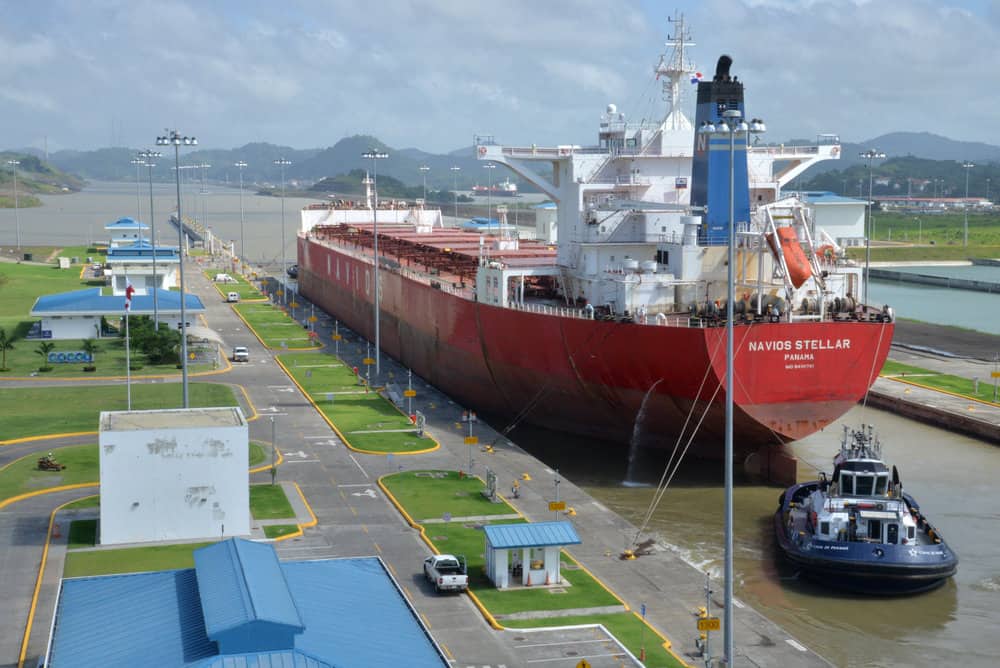In the final installment of a three-part series, FreightWaves examines prospects dry bulk commodities transiting the Panama Canal. Part One featured the outlook for liquid bulk and Part Two focused on container shipping.
Since the Panama Canal’s larger ‘Neopanamax’ locks debuted in June 2016, the spotlight has shone on container ships and carriers of liquefied natural gas and liquefied petroleum gas. There has been relatively little focus on dry bulk, even though it remains the canal’s highest-volume cargo type by far.
The Neopanamax locks, which recently celebrated their one-thousandth day in service, allow passage of Capesize bulker of up to 205,000 deadweight tons (DWT) in ballast (empty), or partially loaded with up to 129,000 DWT of cargo, due to water-depth restrictions.
During the most recent fiscal year (October 2017-September 2018), dry bulk cargoes – primarily grains and coal – accounted for 47 percent of volume through the original Panamax locks, 14 percent through the newer Neopanamax locks, and 36 percent through both locks combined, topping runner-up container shipping’s 22 percent share of total cargo volume. Statistics from the Panama Canal Authority (ACP) confirm that dry bulk’s dominance continues in the first six months of FY2019, through March.
Two key trends are playing out – one in the Panamax locks, the other in the Neopanamax locks.
In the Panamax locks, U.S. agribulk (primarily soybeans, sorghum and corn) is an important component of dry bulk volumes traversing the waterway en route to Asia.
“We have seen a decrease in volume because much of the grain coming from the United States is going on routes other than the Panama Canal”
U.S. agribulk shippers did not switch to larger vessels via the Neopanamax locks because grain elevators and loading facilities along the U.S. Gulf are designed to handle 65,000-90,000 DWT Panamax bulkers, not larger 100,000 DWT-plus Capesize bulkers.
Panamax decline
The trend in the Panamax locks has been towards decreased volumes coinciding with U.S.-China trade tensions. In FY2018, soybean volumes moving from the Atlantic to Pacific Basins fell 43 percent and sorghum volumes dropped 34 percent. China is replacing its U.S. purchases with cargoes from Brazil and Argentina, which travel via the Cape of Good Hope, not the Panama Canal.
According to ACP senior trade specialist Argelis Moreno de Ducreux, “We have seen a decrease in volume because much of the grain coming from the United States is going on routes other than the Panama Canal.”
She attributed the trend partly to the low charter rates for bulkers, which allow shippers to take longer routes and avoid canal tolls. “There has been so much of an oversupply of vessels that charter rates are very low, and bunker prices are also low, so they can afford to use alternative routes like the Cape of Good Hope,” she explained in an interview with FreightWaves.
Total dry bulk volume through the Panamax locks fell 9 percent in FY2018, and the downward trend continues in the first half of the current fiscal year. According to ACP statistics, dry bulk cargo volumes through the Panamax locks fell 5 percent in the October 2018-March 2019 period compared with the same period in the prior year.
Colombian coal
Over in the larger Neopanamax locks, a very different – and positive – trend is taking root. Here, Colombian coal shippers have emerged as the predominant customers, and demand is growing, albeit at levels that are still just one-fifth of those in the Panamax locks. Neopanamax bulk cargo volumes jumped 49 percent in FY2018 compared to FY2017, to 11.5 million long tons (1 long ton = 2,240 pounds), and were up another 38 percent in the first half of FY2019.
“The biggest volumes we have seen through the Neopanamax locks are coal loaded at the Colombian ports on the Caribbean side, going to Chile and Guatemala on the Pacific side, as well as to Asia,” said De Ducreux.
She explained that 52 percent of the bulkers transiting these locks have carried coal, with 59 percent of those vessels loading in Colombia. She added that shippers are using both Panamaxes and Capesizes to transport the coal.
De Ducreux noted that there are also at least a few Panamaxes loading grain in the U.S. Gulf that have switched to the Neopanamax locks, although the number is still very small. There have been 13 Panamax transits from the U.S. Gulf to Asia through the Neopanamax locks since June 2016. The new locks have a deeper water depth, which allows agribulk shippers to more fully utilize Panamax cargo holds.
The outlook for dry bulk volumes transiting the Panama Canal remains unclear. For the Neopanamax locks, the driver will be Colombian coal production. Analyst Fitch Solutions recently lowered its 2019 Colombian production outlook from 4.5 percent growth to 0 percent, citing weaker pricing prospects.
The outlook for bulk cargoes through the Panamax locks hinges on the outcome of the U.S.-China trade talks, and the eventual destination of U.S. soybeans.
Further clouding the forecast is the drought in Panama, leading to an ongoing string of draft restriction announcements, with the latest restriction – to a maximum draft of 45 feet – effective on April 10. Such restrictions reduce the cargo load per bulk carrier, negatively affecting voyage economics for shippers.








